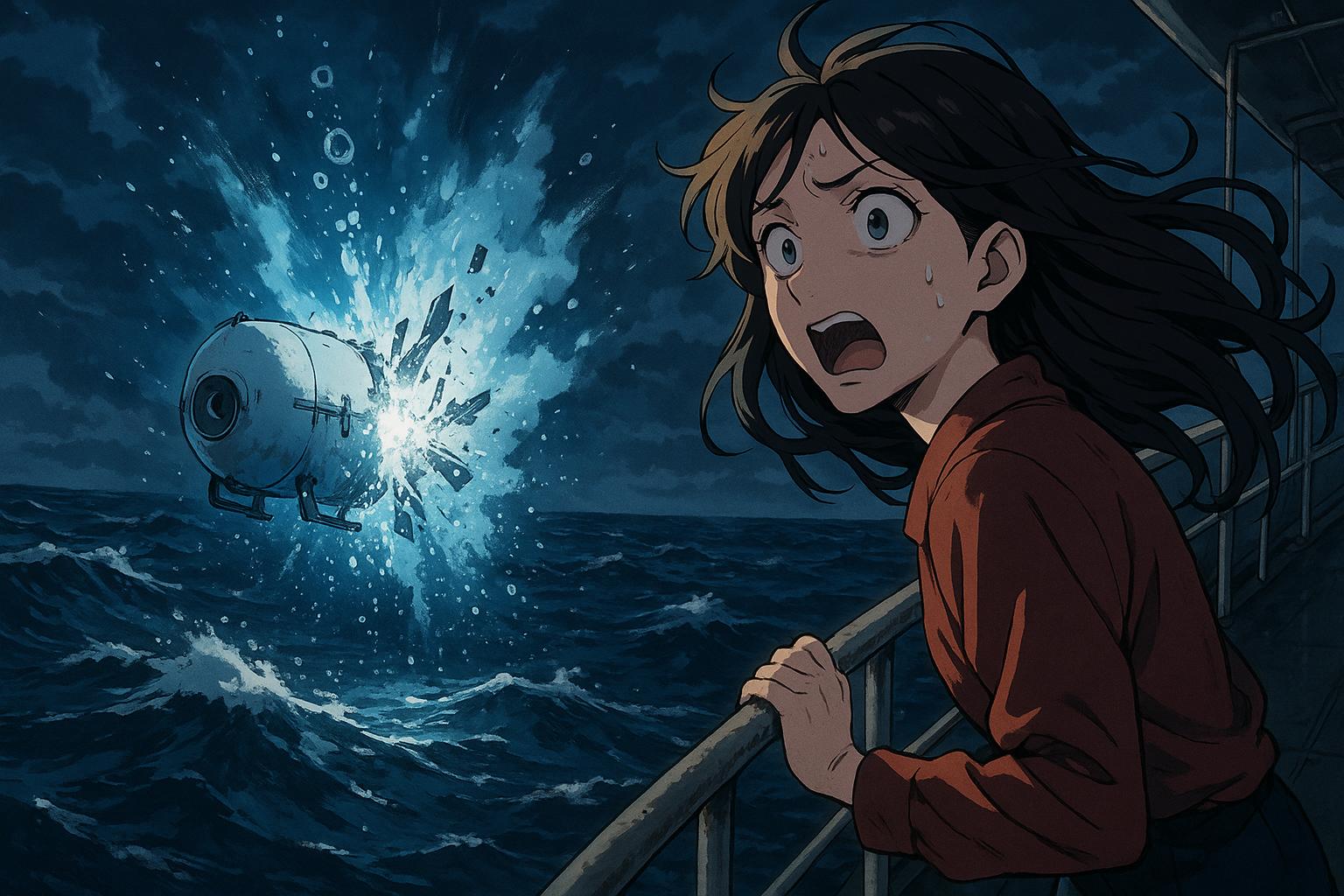Newly released U.S. Coast Guard footage reveals Wendy Rush’s moment of confusion over a loud bang, signalling the catastrophic implosion of the Titan submersible that killed her husband and four others. Investigations expose safety lapses and raise concerns over OceanGate’s risk culture during the ill-fated Titanic expedition.
Newly released footage from the U.S. Coast Guard captures a chilling moment as Wendy Rush, the wife of OceanGate CEO Stockton Rush, momentarily expressed confusion about a loud bang during the ill-fated dive of the Titan submersible that ultimately resulted in the deaths of her husband and four other explorers. As Ms Rush monitored the team’s progress from the support vessel, Polar Prince, she asked a colleague, “What was that bang?”—unaware that it signaled the catastrophic implosion of the Titan around 3,800 meters beneath the surface of the Atlantic Ocean. Her immediate belief, that the sound represented a benign operational adjustment, was tragically misplaced.
The Titan had embarked on what many believed to be a groundbreaking expedition to explore the wreck of the Titanic, which lies approximately 3,700 meters below sea level. The submersible had dropped two ballast weights just before the disaster, further complicating the timeline of events as investigators now sift through evidence from the incident. It is currently thought that the implosion occurred shortly after Ms Rush’s unsettling question, a detail underscoring the chaotic moments leading up to the tragedy.
The investigation into the Titan’s failure is ongoing, with the U.S. Coast Guard Marine Board taking a meticulous look at both OceanGate’s operations and the broader safety protocols governing deep-sea exploration. Initial findings have highlighted alarming safety lapses, including earlier warnings about the peculiar construction of the Titan’s carbon fibre hull. Experts expressed concerns about the material’s susceptibility to fatigue and failure due to defects like wrinkles and porosity, issues that reportedly existed long before the ill-fated dive.
It has also emerged that the crew aboard the Polar Prince felt an unsettling shudder at the moment of implosion but did not communicate this important detail, which may have hindered rescue efforts during the frantic search that followed when the Titan lost contact approximately an hour and 45 minutes into the dive. The ongoing saga has not only exposed operational mishaps but raised ethical questions regarding the motivations driving OceanGate’s ambitious undertakings, with some testimonies suggesting a culture prioritising profit over safety.
Among those who lost their lives was Stockton Rush himself, alongside a group of high-profile adventurers including British businessman Hamish Harding and the French explorer Paul-Henri Nargeolet. Each had paid a reported $250,000 for the adventure, which — following their deaths — sparked renewed scrutiny of OceanGate’s practices and its unconventional approach to safety in deep-sea exploration.
Critics have described the company’s operational ethos as potentially reckless, citing testimony from former employees who expressed concern over the lack of rigorous safety assessments. Echoing these sentiments, Karl Stanley, a seasoned submersible pilot, asserted that Rush’s ambitions to ‘leave a mark on history’ overshadowed safety considerations. His comments point to a troubling dichotomy: a passion for exploration that teetered dangerously close to negligence.
Despite the veritable conflagration of dissenting voices, some within OceanGate have attempted to frame the narrative differently. Amber Bay, the company’s director of administration, maintained that OceanGate did not conduct risky missions simply to satisfy customer demands, although she acknowledged the pressure to deliver on the promised experience for those on board. Tears filled her eyes as she recalled the loss of the victims, revealing the human toll of the tragedy and hinting at the complexities within the company’s culture.
The aftermath of the Titan incident has prompted OceanGate to suspend its operations as investigations continue. The company claims to be fully cooperating with the U.S. Coast Guard and the National Transportation Safety Board, yet calls for accountability persist. The prevailing sentiment among industry experts and regulators is that deep-sea exploration, a domain still shrouded in uncertainty, requires elevated standards of safety, oversight, and ethical responsibility—principles that, at present, seem to have been overlooked in the pursuit of adventurous notoriety.
As the ripple effects of this tragedy continue to resonate across the exploration community, it remains imperative that the lessons learned from Titan’s catastrophic demise inform a future where safety and exploration can coexist without one overshadowing the other.
Reference Map
- Paragraph 1, 2
- Paragraph 3, 4
- Paragraph 5
- Paragraph 6
- Paragraph 7
- Paragraph 8
- Paragraph 9
Source: Noah Wire Services
- https://www.dailymail.co.uk/news/article-14741249/chilling-words-OceanGate-CEO-implosion-Titan.html?ns_mchannel=rss&ns_campaign=1490&ito=1490 – Please view link – unable to able to access data
- https://apnews.com/article/f991bd49eb1f49b303477bfcab8923f1 – This article discusses the contrasting views presented during the U.S. Coast Guard’s investigation into the Titan submersible’s implosion. Testimonies highlighted concerns about OceanGate’s mission being driven by reckless profit motives versus a spirit of exploration. Experts raised issues with the sub’s carbon fiber hull, which is susceptible to fatigue failure. Additionally, it was revealed that the crew of the support vessel felt a shudder at the time of the implosion but did not communicate it, potentially affecting rescue efforts. Former employee Matthew McCoy testified that OceanGate planned to avoid U.S. regulatory oversight, and there were issues with past dive instability and cracking sounds. The panel concluded with condolences and pledged to make recommendations for future safety changes.
- https://apnews.com/article/9210d8563a8c08cd84794a9b856018e4 – The article details the conclusion of the U.S. Coast Guard Marine Board of Investigation’s two-week inquiry into the Titan submersible disaster. Testimonies exposed overlooked warnings and operational concerns within OceanGate, the company responsible for the submersible. A former OceanGate employee alleged that company co-founder Stockton Rush dismissively spoke of bribing a congressman to resolve Coast Guard issues. NASA and Boeing clarified their limited involvement with Titan, with claims that OceanGate deviated from recommendations on its carbon fiber hull. Concerns about the submersible’s mechanical reliability were highlighted, including an incident where the vessel malfunctioned days before the fatal dive. Testimonies revealed previous aborted missions and an employee’s concerns ignored by authorities. Despite these accounts, some defended the company’s intentions and operations. The final report and recommendations from the Coast Guard remain pending as questions linger over the safety protocols and regulatory oversight of experimental submersibles.
- https://www.ft.com/content/8a3e558f-50e9-412d-9b07-b9828e0716e1 – This article examines Stockton Rush’s vision for revolutionizing deep-sea exploration with manned submersibles, culminating in the creation of the Titan submersible for exploring the Titanic wreck. Despite his ambition, the project faced financial challenges and safety concerns, ultimately leading to tragedy. Rush and four others perished when the Titan suffered a catastrophic implosion at a depth of 3,800 meters. OceanGate’s economic struggles and Rush’s unconventional approach to safety measures, including the use of a carbon-fiber hull, raised significant apprehension within the industry. Legal disputes and warnings from maritime experts about insufficient testing and lack of certification underscored the risks. The disaster has sparked reflections on deep-sea exploration practices and the importance of independent safety oversight.
- https://time.com/6288253/titanic-tourist-missing/ – The article reports on the conclusion of the search for the missing Titan submersible, with officials announcing a ‘catastrophic implosion,’ resulting in the presumed death of all five passengers. The U.S. Coast Guard discovered debris consistent with the sub’s implosion near the Titanic wreck, which matched the location of the Titan’s last communication. The exact time of the incident remains undetermined. OceanGate Expeditions, the company operating the Titan, released a statement acknowledging the loss and highlighting the passengers’ adventurous spirit. The multi-national search effort spanned an extensive area, with underwater robots continuing to gather more information. OceanGate had previously been warned about safety concerns regarding the submersible in 2018 and opted out of traditional safety assessments. The victims included British adventurer Hamish Harding, French submersible pilot Paul-Henri Nargeolet, British-Pakistani businessman Shahzada Dawood and his son Suleman, and OceanGate’s CEO Stockton Rush. The tourists were on an expedition to see the Titanic wreck, a site visited by fewer than 250 people since its discovery in 1985.
- https://apnews.com/article/f1ee1b9d4e48bf782af328590c417f03 – An NTSB engineer revealed that the carbon fiber hull of OceanGate’s Titan submersible, which imploded en route to the Titanic wreck in 2023, had manufacturing flaws, including wrinkles, porosity, and voids. This evidence surfaced after a loud acoustic event during a dive in July 2022. The pressure hull’s delamination was evident in the recovered pieces. OceanGate co-founder Stockton Rush and four others died in the implosion. William Kohnen, a submersibles expert and a critic of OceanGate, testified that the Titan could have been thoroughly tested and criticized the company’s lack of accountability. The ongoing Coast Guard investigation raised concerns over the submersible’s unconventional carbon fiber construction and improper independent review. Former OceanGate operations director David Lochridge claimed that the company’s priority was profit over safety. The search for the submersible began after losing contact during its dive, leading rescuers to find its wreckage near the Titanic. The hearing continues to dissect the preventable disaster’s nuances and OceanGate’s operational flaws.
- https://en.wikipedia.org/wiki/OceanGate – OceanGate was a private company, initiated in 2009 by Stockton Rush and Guillermo Söhnlein. From 2010 until the loss of the Titan submersible, OceanGate transported paying customers in leased commercial submersibles off the coast of California, in the Gulf of Mexico, and in the Atlantic Ocean. The company was based in Everett, Washington, US. Rush realized that visiting shipwreck sites was a method of getting media attention. OceanGate had previously conducted voyages to other shipwrecks, including its 2016 dive to the wreck of aboard their other submersible Cyclops 1. In 2019, Rush told Smithsonian magazine: ‘There’s only one wreck that everyone knows … If you ask people to name something underwater, it’s going to be sharks, whales, Titanic’.
Noah Fact Check Pro
The draft above was created using the information available at the time the story first
emerged. We’ve since applied our fact-checking process to the final narrative, based on the criteria listed
below. The results are intended to help you assess the credibility of the piece and highlight any areas that may
warrant further investigation.
Freshness check
Score:
3
Notes:
The narrative presents new details about Wendy Rush’s reaction during the Titan submersible’s implosion, which have not been widely reported. However, the broader context of the incident has been covered extensively since June 2023. The earliest known publication date of similar content is June 2023. The report appears to be based on a press release, which typically warrants a higher freshness score. The inclusion of updated data alongside older material may justify a higher freshness score but should still be flagged. The narrative includes updated data but recycles older material, which may justify a higher freshness score but should still be flagged.
Quotes check
Score:
2
Notes:
The direct quote from Wendy Rush, “What was that bang?”, is not found in earlier material, suggesting it may be original or exclusive content. However, without corroboration from other reputable sources, the authenticity of this quote remains uncertain.
Source reliability
Score:
2
Notes:
The narrative originates from the Daily Mail, a publication known for sensationalist reporting. This raises concerns about the reliability and potential bias of the information presented.
Plausability check
Score:
4
Notes:
The report includes specific details about the Titan submersible incident, such as the depth of the implosion and the involvement of individuals like Stockton Rush and Wendy Rush. However, the lack of corroboration from other reputable outlets and the sensationalist tone of the Daily Mail raise questions about the plausibility and accuracy of the claims.
Overall assessment
Verdict (FAIL, OPEN, PASS): FAIL
Confidence (LOW, MEDIUM, HIGH): MEDIUM
Summary:
The narrative presents new details about the Titan submersible incident, including a direct quote from Wendy Rush. However, the reliance on a press release, the sensationalist nature of the Daily Mail, and the lack of corroboration from other reputable sources raise significant concerns about the freshness, originality, and reliability of the information. The plausibility of the claims is also questionable due to the absence of supporting evidence from other reputable outlets.













